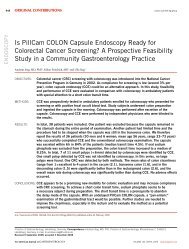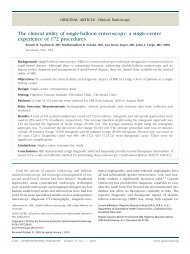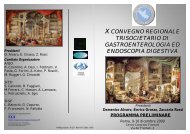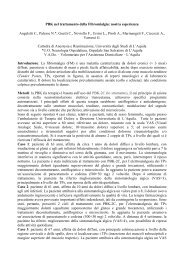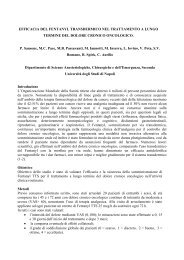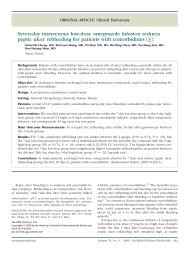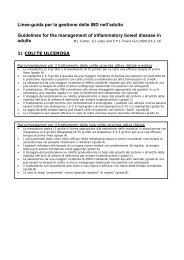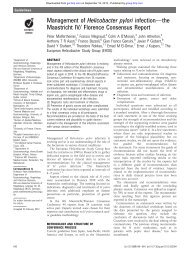Bulb biopsies for the diagnosis of celiac disease in ... - TC Group
Bulb biopsies for the diagnosis of celiac disease in ... - TC Group
Bulb biopsies for the diagnosis of celiac disease in ... - TC Group
You also want an ePaper? Increase the reach of your titles
YUMPU automatically turns print PDFs into web optimized ePapers that Google loves.
ORIGINAL ARTICLE: Cl<strong>in</strong>ical Endoscopy<br />
<strong>Bulb</strong> <strong>biopsies</strong> <strong>for</strong> <strong>the</strong> <strong>diagnosis</strong> <strong>of</strong> <strong>celiac</strong> <strong>disease</strong> <strong>in</strong> pediatric patients<br />
Benedetto Mangiavillano, MD, Enzo Masci, MD, Barbara Parma, MD, Graziano Barera, MD, Paolo Viaggi, MD,<br />
Luca Albarello, MD, Giulia Maria Tronconi, MD, Alberto Mariani, MD, Sabr<strong>in</strong>a Testoni, MD, Tara Santoro, MD,<br />
Pier Alberto Testoni, MD<br />
Milan, Italy<br />
Background: Celiac <strong>disease</strong> (CD) is a gluten-dependent enteropathy. The current standard <strong>for</strong> diagnos<strong>in</strong>g CD<br />
<strong>in</strong>volves obta<strong>in</strong><strong>in</strong>g 4 biopsy samples from <strong>the</strong> descend<strong>in</strong>g duodenum. It has been suggested that duodenal bulb<br />
<strong>biopsies</strong> may also be useful.<br />
Objective: To assess <strong>the</strong> utility <strong>of</strong> bulbar <strong>biopsies</strong> <strong>for</strong> <strong>the</strong> <strong>diagnosis</strong> <strong>of</strong> CD <strong>in</strong> pediatric patients.<br />
Design: Prospective study.<br />
Sett<strong>in</strong>g: S<strong>in</strong>gle center.<br />
Patients: Forty-seven consecutively enrolled pediatric patients with <strong>celiac</strong> serologies and a cl<strong>in</strong>ical suspicion <strong>of</strong> CD.<br />
Interventions: All patients underwent EGD, and 4 biopsy samples were obta<strong>in</strong>ed from <strong>the</strong> duodenal bulb and<br />
4 from <strong>the</strong> descend<strong>in</strong>g duodenum <strong>of</strong> each child.<br />
Ma<strong>in</strong> Outcome Measurements: The pathologist bl<strong>in</strong>dly reported <strong>the</strong> Marsh histological grade <strong>for</strong> <strong>the</strong> <strong>diagnosis</strong><br />
<strong>of</strong> CD <strong>of</strong> <strong>the</strong> bulb and descend<strong>in</strong>g duodenum.<br />
Results: The <strong>diagnosis</strong> <strong>of</strong> CD was histologically confirmed <strong>in</strong> 89.4% (42/47) <strong>of</strong> <strong>the</strong> cases <strong>of</strong> biopsy samples<br />
obta<strong>in</strong>ed from <strong>the</strong> descend<strong>in</strong>g duodenum and <strong>in</strong> all 47 obta<strong>in</strong>ed from <strong>the</strong> bulb. In 35 patients (74.5%), histology<br />
was <strong>the</strong> same <strong>in</strong> <strong>the</strong> bulb and duodenum; <strong>in</strong> 11 (23.4%) cases, <strong>the</strong> grade <strong>of</strong> atrophy was higher <strong>in</strong> <strong>the</strong> bulb than<br />
<strong>in</strong> <strong>the</strong> descend<strong>in</strong>g duodenum, and 5 (10.6%) had bulb histology positive <strong>for</strong> CD but negative duodenal f<strong>in</strong>d<strong>in</strong>gs.<br />
One child (2.1%) had a higher histological grade <strong>in</strong> <strong>the</strong> duodenum than <strong>in</strong> <strong>the</strong> bulb. The diagnostic ga<strong>in</strong> with<br />
bulbar <strong>biopsies</strong> was 10.6%.<br />
Limitations: Small sample and absence <strong>of</strong> a comparison group (asymptomatic children with normal CD antibodies).<br />
Conclusions: We suggest exam<strong>in</strong><strong>in</strong>g 4 biopsy samples from <strong>the</strong> duodenal bulb and 4 from <strong>the</strong> descend<strong>in</strong>g<br />
duodenum to improve diagnostic accuracy <strong>of</strong> CD. (Gastro<strong>in</strong>test Endosc 2010;72:564-8.)<br />
Celiac <strong>disease</strong> (CD) is a gluten-dependent enteropathy<br />
characterized by chronic small <strong>in</strong>test<strong>in</strong>al <strong>in</strong>flammation and<br />
villous atrophy. CD has many atypical manifestations, and<br />
endoscopic f<strong>in</strong>d<strong>in</strong>gs can <strong>in</strong>clude a mosaic pattern <strong>of</strong> <strong>the</strong><br />
duodenal mucosa, reduction or loss <strong>of</strong> duodenal folds,<br />
and scallop<strong>in</strong>g <strong>of</strong> <strong>the</strong> valvulae conniventes. 1 However,<br />
Abbreviations: CD, <strong>celiac</strong> <strong>disease</strong>; HC, hypertrophic crypt; IEL, <strong>in</strong>traepi<strong>the</strong>lial<br />
lymphocyte; M, Marsh histological grade.<br />
DISCLOSURE: All authors disclosed no f<strong>in</strong>ancial relationships relevant to<br />
this publication.<br />
Copyright © 2010 by <strong>the</strong> American Society <strong>for</strong> Gastro<strong>in</strong>test<strong>in</strong>al Endoscopy<br />
0016-5107/$36.00<br />
doi:10.1016/j.gie.2010.05.021<br />
Received September 15, 2009. Accepted May 14, 2010.<br />
Current affiliations: Gastro<strong>in</strong>test<strong>in</strong>al Endoscopy (B.M., E.M., P.V., T.S.), Azienda<br />
Ospedaliera San Paolo University Hospital, University <strong>of</strong> Milan, Departments<br />
endoscopic signs alone are not considered sensitive or<br />
specific <strong>for</strong> <strong>the</strong> <strong>diagnosis</strong> <strong>of</strong> CD. Accord<strong>in</strong>gly, guidel<strong>in</strong>es<br />
published by <strong>the</strong> North American Society <strong>for</strong> Pediatric Gastroenterology<br />
Hepatology and Nutrition state that “confirmation<br />
<strong>of</strong> <strong>the</strong> <strong>diagnosis</strong> <strong>of</strong> CD requires an <strong>in</strong>test<strong>in</strong>al biopsy <strong>in</strong> all<br />
cases.” 2 In particular, <strong>the</strong> current <strong>in</strong>ternationally accepted<br />
<strong>of</strong> Pediatrics (B.P., G.B., G.M.T.), Surgical Pathology (L.A.), Division <strong>of</strong><br />
Gastroenterology and Gastro<strong>in</strong>test<strong>in</strong>al Endoscopy (A.M., S.T., P.A.T.),<br />
Scientific Institute H. San Raffaele, Vita-Salute University, Milan, Italy.<br />
Repr<strong>in</strong>t requests: Benedetto Mangiavillano, MD, Gastro<strong>in</strong>test<strong>in</strong>al Endoscopy,<br />
San Paolo University Hospital, Via A. di Rud<strong>in</strong>ì 8, 20142 Milan, Italy.<br />
If you would like to chat with an author <strong>of</strong> this article, you may contact Dr.<br />
Mangiavillano at b_mangiavillano@hotmail.com.<br />
564 GASTROINTESTINAL ENDOSCOPY Volume 72, No. 3 : 2010 www.giejournal.org
Mangiavillano et al<br />
<strong>Bulb</strong> <strong>biopsies</strong> to diagnose CD <strong>in</strong> children<br />
standard <strong>for</strong> <strong>the</strong> <strong>diagnosis</strong> <strong>of</strong> CD is 4 biopsy samples from <strong>the</strong><br />
4 quadrants <strong>of</strong> <strong>the</strong> descend<strong>in</strong>g duodenum. 3<br />
Pais et al 4 recently published <strong>the</strong> results <strong>of</strong> a study <strong>in</strong><br />
which <strong>the</strong>y exam<strong>in</strong>ed 247 patients to determ<strong>in</strong>e how many<br />
duodenal biopsy specimens were needed to diagnose CD.<br />
They concluded that only 2 specimens led to confirmation<br />
<strong>of</strong> CD <strong>in</strong> 90% <strong>of</strong> cases and that 4 descend<strong>in</strong>g duodenal<br />
biopsy specimens led to 100% confidence <strong>in</strong> <strong>the</strong> <strong>diagnosis</strong>.<br />
Comparison <strong>of</strong> biopsy specimens from <strong>the</strong> second,<br />
third, and fourth parts <strong>of</strong> <strong>the</strong> duodenum, <strong>the</strong> ligament <strong>of</strong><br />
Treitz, and <strong>the</strong> proximal jejunum has shown that each site<br />
is suitable <strong>for</strong> diagnos<strong>in</strong>g CD. 5 Because mucosal specimens<br />
taken from <strong>the</strong> distal duodenal or jejunal mucosa are<br />
strongly correlated, biopsy samples from <strong>the</strong> second or<br />
third part <strong>of</strong> <strong>the</strong> duodenum are considered adequate to<br />
obta<strong>in</strong> material <strong>for</strong> histological <strong>in</strong>terpretation. 6<br />
The question <strong>of</strong> added utility <strong>of</strong> obta<strong>in</strong><strong>in</strong>g bulbar biopsy<br />
specimens has been less studied. Two articles (an extensive<br />
article and a case report) discussed <strong>the</strong> utility <strong>of</strong> bulb<br />
biopsy specimens <strong>for</strong> diagnos<strong>in</strong>g CD <strong>in</strong> adults <strong>in</strong> addition<br />
to <strong>the</strong> standard 4 from <strong>the</strong> descend<strong>in</strong>g duodenum. O<strong>the</strong>r<br />
studies s<strong>in</strong>ce <strong>the</strong>n have <strong>in</strong>dicated <strong>the</strong> utility <strong>of</strong> duodenal<br />
bulb <strong>biopsies</strong> <strong>for</strong> <strong>the</strong> <strong>diagnosis</strong> <strong>of</strong> CD. 7,8<br />
The diagnostic accuracy <strong>of</strong> endoscopy <strong>in</strong> children with<br />
cl<strong>in</strong>ically suspected CD is particularly important. Per<strong>for</strong>m<strong>in</strong>g<br />
endoscopy <strong>in</strong> children <strong>in</strong>volves an elaborate process <strong>of</strong><br />
ensur<strong>in</strong>g adequate and safe sedation and generally uses<br />
limited and expensive health care resources, <strong>in</strong>clud<strong>in</strong>g<br />
access to pediatric endoscopists and anes<strong>the</strong>sia support.<br />
Pediatric endoscopists have an obligation to make or refute<br />
<strong>the</strong> <strong>diagnosis</strong> <strong>of</strong> CD with certa<strong>in</strong>ty <strong>in</strong> <strong>the</strong>ir young<br />
patients.<br />
The aim <strong>of</strong> this prospective study was to assess <strong>the</strong><br />
utility <strong>of</strong> bulbar <strong>biopsies</strong> <strong>for</strong> confirm<strong>in</strong>g <strong>the</strong> <strong>diagnosis</strong> <strong>of</strong><br />
CD <strong>in</strong> a series <strong>of</strong> pediatric patients with cl<strong>in</strong>ical and serological<br />
<strong>in</strong>dicators <strong>of</strong> <strong>the</strong> <strong>disease</strong>.<br />
MATERIALS AND METHODS<br />
From May 1, 2008, to March 31, 2009, a total <strong>of</strong> 47<br />
children (14 boys and 33 girls; age 8.1 4.59 years) with<br />
suspected CD because <strong>of</strong> positive anti-endomysium IgA<br />
and/or antitissue transglutam<strong>in</strong>ase antibodies IgA and IgG<br />
were prospectively and consecutively enrolled. Their ma<strong>in</strong><br />
cl<strong>in</strong>ical symptoms were iron-deficiency anemia, diarrhea,<br />
abdom<strong>in</strong>al distention, and short stature.<br />
All patients underwent EGD (EG 1840-EG 2940; Pentax,<br />
Hamburg, Germany) dur<strong>in</strong>g which 4 mucosal biopsy samples<br />
were obta<strong>in</strong>ed from <strong>the</strong> duodenal bulb and 4 from <strong>the</strong><br />
descend<strong>in</strong>g duodenum. We chose to take <strong>the</strong> same number<br />
<strong>of</strong> biopsy samples from both <strong>the</strong> bulb and <strong>the</strong> descend<strong>in</strong>g<br />
duodenum to reduce <strong>the</strong> chances that absolute<br />
numbers <strong>of</strong> biopsy specimens from ei<strong>the</strong>r location could<br />
expla<strong>in</strong> a difference <strong>in</strong> diagnostic utility. All endoscopies<br />
were per<strong>for</strong>med with <strong>the</strong> patient under deep sedation with<br />
Prop<strong>of</strong>ol (Prop<strong>of</strong>ol B. Braun 1%; Melsungen, Germany),<br />
Take-home Message<br />
●<br />
In this series <strong>of</strong> patients, 23.4% had a higher histological<br />
atrophy grade <strong>in</strong> <strong>the</strong> bulb than <strong>the</strong> duodenum. A total <strong>of</strong><br />
10.6% <strong>of</strong> patients with <strong>celiac</strong> <strong>disease</strong> (CD) had negative<br />
descend<strong>in</strong>g duodenum histology with bulb biopsy<br />
specimens positive <strong>for</strong> CD. If no bulb biopsy specimens<br />
had been taken, children would not have had a correct<br />
<strong>diagnosis</strong> <strong>of</strong> CD.<br />
and patients were not allowed any solid or liquid foods <strong>in</strong><br />
<strong>the</strong> 8 hours be<strong>for</strong>e <strong>the</strong> procedure. All patients with positive<br />
<strong>celiac</strong> serologies were screened <strong>for</strong> diabetes mellitus.<br />
Biopsy specimens were fixed <strong>in</strong> 10% <strong>for</strong>mal<strong>in</strong> and<br />
sta<strong>in</strong>ed with hematoxyl<strong>in</strong> and eos<strong>in</strong>. A bl<strong>in</strong>ded pathologist<br />
reported <strong>the</strong> Marsh histological grade (M) 9 <strong>for</strong> <strong>the</strong> <strong>diagnosis</strong><br />
<strong>of</strong> CD <strong>in</strong> <strong>the</strong> bulb and descend<strong>in</strong>g duodenum.<br />
The study protocol was approved by <strong>the</strong> hospital’s<br />
ethics committee, and <strong>the</strong> patients’ legal representatives<br />
gave <strong>in</strong><strong>for</strong>med consent <strong>for</strong> <strong>the</strong> procedures and data collection<br />
<strong>for</strong> scientific purposes.<br />
Descriptive statistics are used to present <strong>the</strong> results <strong>of</strong><br />
this exploratory pilot study <strong>in</strong>vestigat<strong>in</strong>g <strong>the</strong> utility <strong>of</strong> bulbar<br />
<strong>biopsies</strong> <strong>for</strong> <strong>the</strong> <strong>diagnosis</strong> <strong>of</strong> CD. Given <strong>the</strong> nature <strong>of</strong><br />
<strong>the</strong> study, a <strong>for</strong>mal calculation <strong>of</strong> study power was not<br />
made.<br />
RESULTS<br />
Table 1 summarizes <strong>the</strong> patients’ ma<strong>in</strong> characteristics.<br />
EGD and specimen collection were successful <strong>in</strong> all 47<br />
children. No procedure- or sedation-related complications<br />
were encountered dur<strong>in</strong>g <strong>the</strong> endoscopy or <strong>in</strong> <strong>the</strong> 24<br />
hours after <strong>the</strong> procedure, and all patients restarted oral<br />
<strong>in</strong>take <strong>the</strong> same day as <strong>the</strong> exam<strong>in</strong>ation.<br />
The <strong>diagnosis</strong> <strong>of</strong> CD was histologically confirmed <strong>in</strong> all<br />
47 patients positive <strong>for</strong> <strong>celiac</strong> serologies. Confirmation was<br />
obta<strong>in</strong>ed <strong>in</strong> 89.4% (42/47) <strong>of</strong> <strong>the</strong> cases with biopsy specimens<br />
from <strong>the</strong> descend<strong>in</strong>g duodenum and <strong>in</strong> 100% <strong>of</strong> <strong>the</strong><br />
cases when <strong>the</strong> <strong>diagnosis</strong> was made from specimens taken<br />
from <strong>the</strong> duodenal bulb.<br />
Histological patterns <strong>in</strong> <strong>the</strong> descend<strong>in</strong>g<br />
duodenum <strong>in</strong> patients with positive serology<br />
<strong>for</strong> CD<br />
In 5 <strong>of</strong> <strong>the</strong> 47 cases, biopsy specimens from <strong>the</strong> descend<strong>in</strong>g<br />
duodenum were negative <strong>for</strong> CD (M 0). Among<br />
<strong>the</strong> 42 children <strong>in</strong> whom <strong>the</strong> <strong>diagnosis</strong> <strong>of</strong> CD was confirmed<br />
from descend<strong>in</strong>g duodenal biopsy samples, 2<br />
showed only <strong>in</strong>traepi<strong>the</strong>lial lymphocytes (IELs) (correspond<strong>in</strong>g<br />
to M 1); <strong>in</strong> 2 o<strong>the</strong>rs, <strong>the</strong> <strong>diagnosis</strong> was based on<br />
IELs plus hypertrophic crypts (HCs) (correspond<strong>in</strong>g to M<br />
2), whereas <strong>in</strong> <strong>the</strong> rema<strong>in</strong><strong>in</strong>g 38 cases, <strong>the</strong> <strong>diagnosis</strong> was<br />
www.giejournal.org Volume 72, No. 3 : 2010 GASTROINTESTINAL ENDOSCOPY 565
<strong>Bulb</strong> <strong>biopsies</strong> to diagnose CD <strong>in</strong> children<br />
Mangiavillano et al<br />
TABLE 1. Serological features and symptoms <strong>of</strong> 47<br />
children with suspected <strong>celiac</strong> <strong>disease</strong><br />
Features and symptoms Patients, no. (%)<br />
EmA IgA positive 47 (100)<br />
tTG-Ab IgA positive 47 (100)<br />
tTG-Ab IgG positive 47 (100)<br />
Iron-deficiency anemia 36 (76.6)<br />
TABLE 3. <strong>Bulb</strong> and duodenal histology (different or<br />
same) <strong>in</strong> <strong>the</strong> 47 patients<br />
Histology (Marsh grade) Patients, no. (%)<br />
<strong>Bulb</strong> positive/duodenal negative 5 (10.6)<br />
<strong>Bulb</strong> duodenal 6 (12.8)<br />
<strong>Bulb</strong> duodenal 35 (74.5)<br />
Duodenal bulb 1 (2.1)<br />
Diarrhea 25 (53.2)<br />
Abdom<strong>in</strong>al distention 15 (31.9)<br />
Short stature 9 (19.1)<br />
EmA IgA, Anti-endomysium IgA; tTG-Ab, anti-tissue transglutam<strong>in</strong>ase<br />
antibody.<br />
TABLE 2. Histological patterns <strong>of</strong> <strong>the</strong> bulb and <strong>the</strong><br />
descend<strong>in</strong>g duodenum<br />
Histology (Marsh grade)<br />
<strong>Bulb</strong>ar<br />
histology<br />
(47 patients)<br />
Descend<strong>in</strong>g<br />
duodenum<br />
histology<br />
(47 patients)<br />
No <strong>diagnosis</strong> (M 0) 0 (0%) 5 (10.6%)<br />
Intraepi<strong>the</strong>lial lymphocytes<br />
(M 1)<br />
Intraepi<strong>the</strong>lial lymphocytes <br />
hypertrophic crypts (M 2)<br />
Intraepi<strong>the</strong>lial lymphocytes <br />
hypertrophic crypts <br />
villous atrophy (M 3a,b,c)<br />
M, Marsh histological grade.<br />
3 (6.4%) 2 (4.3%)<br />
2 (4.3%) 2 (4.3%)<br />
42 (89.4%) 38 (80.8%)<br />
based on IELs plus HCs and villous atrophy (M 3a,b,c)<br />
(Table 2).<br />
Histological patterns <strong>in</strong> <strong>the</strong> duodenal bulb <strong>in</strong><br />
patients with positive serology <strong>for</strong> CD<br />
All <strong>the</strong> bulbar biopsy samples provided histological<br />
evidence <strong>of</strong> CD. In 3 cases, <strong>the</strong> <strong>diagnosis</strong> was based on <strong>the</strong><br />
presence <strong>of</strong> IELs (M 1), <strong>in</strong> 2, it was based on IELs plus HCs<br />
(M 2), and <strong>in</strong> 42, it was based on IELs plus HCs and villous<br />
atrophy (M 3a,b,c) (Table 2).<br />
Comparison <strong>of</strong> descend<strong>in</strong>g duodenum and<br />
duodenal bulb biopsy specimens <strong>in</strong> patients<br />
with positive serology <strong>for</strong> CD<br />
Thirty-five patients (74.4%) had <strong>the</strong> same histology <strong>in</strong><br />
<strong>the</strong> bulb and descend<strong>in</strong>g duodenum: 1 patient had M 1<br />
(2.9%), 6 had M 3a (17.1%), 10 had M 3b (28.6%), and 18<br />
had M 3c (51.4%). In 12 cases, however, <strong>the</strong> histological<br />
f<strong>in</strong>d<strong>in</strong>gs differed <strong>in</strong> <strong>the</strong> bulb and <strong>the</strong> distal duodenum: <strong>in</strong><br />
1 patient (2.2% <strong>of</strong> <strong>the</strong> total cohort), <strong>the</strong> grade <strong>of</strong> atrophy<br />
<strong>in</strong> <strong>the</strong> descend<strong>in</strong>g duodenum (M 3b) was higher than that<br />
<strong>in</strong> <strong>the</strong> bulb (M 3a), whereas <strong>in</strong> all <strong>the</strong> o<strong>the</strong>r 11 patients<br />
(23.4%), <strong>the</strong> opposite was true. In 5 <strong>of</strong> <strong>the</strong>se 11 patients,<br />
bulb histology was positive <strong>for</strong> CD (2 with pattern M 1, 2<br />
with pattern M 2, and 1 with pattern M 3b), whereas <strong>the</strong><br />
duodenal <strong>biopsies</strong> were negative <strong>for</strong> CD (M 0). In <strong>the</strong><br />
o<strong>the</strong>r 6 patients, biopsy samples from both duodenal sites<br />
showed atrophy, but <strong>the</strong> histological grade was higher <strong>for</strong><br />
those taken from <strong>the</strong> duodenal bulb than <strong>for</strong> those from<br />
<strong>the</strong> descend<strong>in</strong>g duodenum (Table 3).<br />
The diagnostic ga<strong>in</strong> with bulbar <strong>biopsies</strong> compared<br />
with descend<strong>in</strong>g duodenum <strong>biopsies</strong> alone was 10.6%.<br />
DISCUSSION<br />
In our series <strong>of</strong> 47 patients with cl<strong>in</strong>ical and serological<br />
<strong>in</strong>dicators <strong>of</strong> CD, 23.4% had a higher grade <strong>of</strong> histological<br />
atrophy <strong>in</strong> <strong>the</strong> bulb than <strong>in</strong> <strong>the</strong> descend<strong>in</strong>g duodenum,<br />
and 10.6% did not show histological signs <strong>of</strong> CD on biopsy<br />
samples from <strong>the</strong> descend<strong>in</strong>g duodenum, although bulb<br />
biopsy samples were positive <strong>for</strong> CD. If no bulb biopsy<br />
samples had been taken from this latter group, it would<br />
not have been possible to make <strong>the</strong> <strong>diagnosis</strong> <strong>of</strong> CD<br />
correctly. Consider<strong>in</strong>g that mucosal specimens from <strong>the</strong><br />
distal duodenal or jejunal mucosa are strongly correlated,<br />
that <strong>the</strong>se biopsy specimens provide adequate material <strong>for</strong><br />
histological <strong>in</strong>terpretation, 4 and that studies on <strong>the</strong> usefulness<br />
<strong>of</strong> bulbar <strong>biopsies</strong> <strong>in</strong> <strong>the</strong> <strong>diagnosis</strong> <strong>of</strong> CD have been<br />
<strong>in</strong>conclusive, we decided to compare bulbar and duodenal<br />
histology <strong>in</strong> patients with suspected CD.<br />
The higher grade <strong>of</strong> bulb atrophy <strong>in</strong> 23.4% <strong>of</strong> patients <strong>in</strong><br />
our series might be expla<strong>in</strong>ed by <strong>the</strong> fact that <strong>the</strong> duodenal<br />
bulb is particularly rich <strong>in</strong> lymphatic structures 10 and is <strong>the</strong><br />
first portion to be reached by gluten. 8<br />
The limitations <strong>of</strong> this study are its small sample size,<br />
<strong>the</strong> absence <strong>of</strong> a comparison group (asymptomatic children<br />
with normal CD antibodies), and <strong>the</strong> lack <strong>of</strong> <strong>in</strong>clusion<br />
<strong>in</strong> <strong>the</strong> study <strong>of</strong> children with a family history <strong>of</strong> CD or o<strong>the</strong>r<br />
autoimmune disorders.<br />
In 2001, Vogelsang et al, 8 after f<strong>in</strong>d<strong>in</strong>g 2 cases <strong>of</strong> CD <strong>in</strong><br />
which biopsy samples from <strong>the</strong> duodenal bulb were diag-<br />
566 GASTROINTESTINAL ENDOSCOPY Volume 72, No. 3 : 2010 www.giejournal.org
Mangiavillano et al<br />
<strong>Bulb</strong> <strong>biopsies</strong> to diagnose CD <strong>in</strong> children<br />
TABLE 4. Symptoms, hemoglob<strong>in</strong> concentration, and red blood cell count <strong>in</strong> patients with a Marsh 1 grade <strong>celiac</strong> <strong>disease</strong> <strong>diagnosis</strong><br />
Patient<br />
March histology grade<br />
<strong>Bulb</strong> Descend<strong>in</strong>g duodenum Symptoms<br />
Hb (g/dL)<br />
RBC count (10 9 /L)<br />
1 1 1 Occasional diarrhea 12.3 4.36<br />
2 1 0 Bloat<strong>in</strong>g 11.8 4.38<br />
3* 1 0 No 15.4 5.25<br />
Hb, Hemoglob<strong>in</strong>; RBC, red blood cell.<br />
*Patient 3 was tested <strong>for</strong> serological CD antibodies because <strong>of</strong> a family history <strong>of</strong> CD.<br />
nostic, retrospectively analyzed biopsy samples from <strong>the</strong><br />
descend<strong>in</strong>g duodenum and duodenal bulb <strong>of</strong> 51 patients<br />
with suspected or diagnosed CD. The number <strong>of</strong> IELs was,<br />
on average, higher <strong>in</strong> <strong>the</strong> descend<strong>in</strong>g part <strong>of</strong> <strong>the</strong> duodenum,<br />
although <strong>the</strong> difference was not statistically significant,<br />
and <strong>the</strong> conclusion was that most patients with CD<br />
show similar mucosal changes <strong>in</strong> biopsy samples from <strong>the</strong><br />
descend<strong>in</strong>g duodenum and from <strong>the</strong> bulb.<br />
Traditionally, biopsy samples from <strong>the</strong> duodenal bulb<br />
have not been recommended on <strong>the</strong> assumption that histological<br />
f<strong>in</strong>d<strong>in</strong>gs <strong>in</strong> specimens from this area may be<br />
difficult to <strong>in</strong>terpret. Compared with <strong>the</strong> distal duodenum,<br />
<strong>the</strong> bulb has more Brunner’s glands and lymphoid tissue<br />
and may show gastric metaplasia. 11 The villi <strong>in</strong> <strong>the</strong> bulb<br />
may also be shorter and broader, 12,13 and some authors<br />
ma<strong>in</strong>ta<strong>in</strong> that villi <strong>in</strong> <strong>the</strong> bulb may be blunted or even<br />
absent over Brunner’s glands. 14,15 Fur<strong>the</strong>rmore, duodenitis<br />
from o<strong>the</strong>r causes can <strong>in</strong>terfere with <strong>the</strong> <strong>in</strong>terpretation <strong>of</strong><br />
villous atrophy <strong>in</strong> this region.<br />
In fact, <strong>the</strong> duodenal bulb is still not considered a useful<br />
site <strong>for</strong> target <strong>biopsies</strong> <strong>for</strong> <strong>the</strong> <strong>diagnosis</strong> <strong>of</strong> CD, even<br />
though this site has rarely been reported to be <strong>the</strong> only<br />
one show<strong>in</strong>g reliable histological changes <strong>in</strong> adults and<br />
children with CD. 16 It is also already known that normal<br />
subjects have normal histology <strong>of</strong> <strong>the</strong> bulb and descend<strong>in</strong>g<br />
duodenum. 17<br />
Brocchi et al 7 presented a case <strong>in</strong> which <strong>the</strong> <strong>diagnosis</strong> <strong>of</strong><br />
CD was based only on biopsy samples from <strong>the</strong> duodenal<br />
bulb, and Bonamico et al 16 described 5 children with<br />
descend<strong>in</strong>g duodenum biopsy samples negative <strong>for</strong> CD <strong>in</strong><br />
whom <strong>the</strong> first <strong>diagnosis</strong> <strong>of</strong> <strong>the</strong> <strong>disease</strong> was possible only<br />
after subsequent bulbar <strong>biopsies</strong>.<br />
Bonamico et al 18 also conducted a large population<br />
study on 665 children, randomized <strong>in</strong>to 2 groups on <strong>the</strong><br />
basis <strong>of</strong> <strong>the</strong> suspicion <strong>of</strong> CD because <strong>of</strong> positive antibodies.<br />
Of <strong>the</strong>se 665 children, 16 (2.4%) had positive CD<br />
antibodies and histological lesions <strong>in</strong> <strong>the</strong> bulb compatible<br />
with CD, but a histologically normal mucosal pattern <strong>in</strong> <strong>the</strong><br />
descend<strong>in</strong>g duodenum, with normal villi, normal CD3<br />
lymphocyte count, and no HCs. We found a much higher<br />
frequency <strong>of</strong> patients with bulb-positive but descend<strong>in</strong>g<br />
duodenum-negative biopsy samples (10.6%). Consider<strong>in</strong>g<br />
<strong>the</strong> patchy histological distribution <strong>of</strong> CD, this difference<br />
could perhaps be expla<strong>in</strong>ed by <strong>the</strong> higher number <strong>of</strong><br />
biopsy samples taken from our patients. However, while<br />
this paper was <strong>in</strong> preparation, Weir et al 19 published <strong>the</strong><br />
results <strong>of</strong> <strong>the</strong>ir study, report<strong>in</strong>g on 101 children from<br />
whom biopsy samples were taken from both <strong>the</strong> duodenal<br />
bulb and <strong>the</strong> second portion <strong>of</strong> <strong>the</strong> duodenum; <strong>in</strong> 10 cases<br />
(9.9%), only <strong>the</strong> duodenal bulb biopsy samples were diagnostic<br />
<strong>of</strong> CD. This is remarkably similar to our f<strong>in</strong>d<strong>in</strong>gs.<br />
It is possible that <strong>the</strong> majority <strong>of</strong> cases with negative<br />
duodenal biopsy samples and positive bulbar ones have a<br />
low Marsh grade. This could expla<strong>in</strong> why <strong>the</strong> symptoms <strong>in</strong><br />
this subgroup <strong>of</strong> patients were mild (Table 4) compared<br />
with those <strong>of</strong> patients with marked villous atrophy. However,<br />
<strong>in</strong> a recent study by Prasad et al 20 <strong>of</strong> 52 children from<br />
whom bulbar and descend<strong>in</strong>g duodenum biopsy samples<br />
were taken, no significant differences were found between<br />
<strong>the</strong> histology <strong>in</strong> <strong>the</strong> 2 sites, lead<strong>in</strong>g to <strong>the</strong> conclusion<br />
that <strong>the</strong> <strong>diagnosis</strong> <strong>of</strong> CD can be made even if biopsy<br />
samples are taken from <strong>the</strong> duodenal bulb ra<strong>the</strong>r than <strong>the</strong><br />
distal duodenum or jejunum.<br />
Despite reports <strong>in</strong> which <strong>the</strong> <strong>diagnosis</strong> <strong>of</strong> CD was obta<strong>in</strong>ed<br />
with <strong>the</strong> aid <strong>of</strong> bulb <strong>biopsies</strong>, 6,7,21 Ravelli et al, 22 <strong>in</strong><br />
110 untreated CD patients, found no cases <strong>in</strong> which biopsy<br />
samples from <strong>the</strong> descend<strong>in</strong>g duodenum were negative<br />
<strong>for</strong> CD, but bulb biopsy samples were positive.<br />
The importance <strong>of</strong> mak<strong>in</strong>g or refut<strong>in</strong>g a <strong>diagnosis</strong> <strong>of</strong> CD<br />
cannot be overstated. Although an early correct <strong>diagnosis</strong><br />
<strong>of</strong> CD <strong>in</strong> pediatric patients is translated <strong>in</strong>to a ga<strong>in</strong> <strong>of</strong><br />
weight; <strong>the</strong> disappearance <strong>of</strong> CD-related symptoms; reestablishment<br />
<strong>of</strong> a normal hemoglob<strong>in</strong> concentration, mean<br />
cell volume, and red blood cell count; and prevention <strong>of</strong><br />
potentially fatal complications such as lymphoma and jejunoileal<br />
ulcerative <strong>disease</strong>, <strong>the</strong> <strong>diagnosis</strong> currently <strong>in</strong>volves<br />
committ<strong>in</strong>g a child to a lifetime <strong>of</strong> a gluten-free diet,<br />
which has been associated with a negative impact on <strong>the</strong><br />
quality <strong>of</strong> life, and <strong>the</strong> <strong>diagnosis</strong> must not, <strong>the</strong>re<strong>for</strong>e, be<br />
applied without <strong>the</strong> histological certa<strong>in</strong>ty that <strong>the</strong> child has<br />
<strong>the</strong> <strong>disease</strong>. Conversely, if <strong>the</strong> <strong>diagnosis</strong> is missed dur<strong>in</strong>g<br />
endoscopy, <strong>the</strong> child risks cont<strong>in</strong>u<strong>in</strong>g to have symptoms,<br />
possibly requir<strong>in</strong>g a repeat endoscopy <strong>in</strong> <strong>the</strong> future.<br />
In conclusion, although fur<strong>the</strong>r studies are needed to<br />
confirm our results <strong>in</strong> patients with positive CD antibodies,<br />
we suggest tak<strong>in</strong>g biopsy samples from both <strong>the</strong> duodenal<br />
www.giejournal.org Volume 72, No. 3 : 2010 GASTROINTESTINAL ENDOSCOPY 567
<strong>Bulb</strong> <strong>biopsies</strong> to diagnose CD <strong>in</strong> children<br />
Mangiavillano et al<br />
bulb and <strong>the</strong> descend<strong>in</strong>g duodenum to maximize <strong>the</strong> diagnostic<br />
yield and make <strong>the</strong> <strong>diagnosis</strong> <strong>of</strong> CD more certa<strong>in</strong>.<br />
In our study, 4 biopsy samples from each site enabled <strong>the</strong><br />
<strong>diagnosis</strong> <strong>of</strong> CD to be confirmed <strong>in</strong> 100% <strong>of</strong> <strong>the</strong> cases.<br />
REFERENCES<br />
1. Brocchi E, Corazza GR, Caletti G, et al. Unsuspected <strong>celiac</strong> <strong>disease</strong> diagnosed<br />
by endoscopic visualization <strong>of</strong> duodenal bulb micronodules.<br />
Gastro<strong>in</strong>test Endosc 1996;44:610-1.<br />
2. Hill ID, Dirks MH, Dirks GS, et al. Guidel<strong>in</strong>e <strong>for</strong> <strong>diagnosis</strong> and treatment <strong>of</strong><br />
<strong>celiac</strong> <strong>disease</strong> <strong>in</strong> children: recommendations <strong>of</strong> <strong>the</strong> North American Society<br />
<strong>of</strong> Pediatric Gastroenterology, Hepatology and Nutrition. J Pediatr<br />
Gastroenterol Nutr 2005;40:1-19.<br />
3. Walker-Smith JA, Guandal<strong>in</strong>i S, Schimtz J. Revised criteria <strong>for</strong> <strong>diagnosis</strong><br />
<strong>of</strong> coeliac <strong>disease</strong>. Arch Dis Child 1990;65:909-11.<br />
4. Pais WP, Duerksen DR, Pettigrew NM, et al. How many duodenal biopsy<br />
specimens are required to make a <strong>diagnosis</strong> <strong>of</strong> <strong>celiac</strong> <strong>disease</strong> Gastro<strong>in</strong>test<br />
Endosc 2008;67:1082-7.<br />
5. Dandalides SM, Carey WD, Petras R, et al. Endoscopic small bowel mucosal<br />
biopsy: a controlled trial evaluat<strong>in</strong>g <strong>for</strong>ceps size and biopsy location<br />
<strong>in</strong> <strong>the</strong> <strong>diagnosis</strong> <strong>of</strong> normal and abnormal mucosal architecture.<br />
Gastro<strong>in</strong>test Endosc 1989;35:197-200.<br />
6. Meijer JWR, Wahab PJ, Mulder CJJ. Small <strong>in</strong>test<strong>in</strong>al <strong>biopsies</strong> <strong>in</strong> <strong>celiac</strong><br />
<strong>disease</strong>: duodenal or jejunal Virchows Arch 2003;442:124-8.<br />
7. Brocchi E, Tomassetti P, Volta U, et al. Adult coeliac <strong>disease</strong> diagnosed by<br />
endoscopic <strong>biopsies</strong> <strong>in</strong> <strong>the</strong> duodenal bulb. Eur J Gastroenterol Hepatol<br />
2005;17:1413-5.<br />
8. Vogelsang H, Hänel S, Ste<strong>in</strong>er B, et al. Diagnostic duodenal bulb biopsy<br />
<strong>in</strong> <strong>celiac</strong> <strong>disease</strong>. Endoscopy 2001;33:336-40.<br />
9. Marsh MN. Gluten, major histocompatibility complex, and <strong>the</strong> small <strong>in</strong>test<strong>in</strong>e:<br />
a molecular and immunobiological approach to <strong>the</strong> spectrum <strong>of</strong><br />
gluten sensitivity (‘<strong>celiac</strong> sprue’). Gastroenterology 1992;102:330-54.<br />
10. Trier JS. Diagnostic value <strong>of</strong> peroral biopsy <strong>of</strong> <strong>the</strong> proximal small <strong>in</strong>test<strong>in</strong>e.<br />
N Engl J Med 1971;285:1470-3.<br />
11. Holdstock G, Eade OE, Isaacson P, et al. Endoscopic duodenal <strong>biopsies</strong> <strong>in</strong><br />
coeliac <strong>disease</strong> and duodenitis. Scand J Gastroenterol 1979;14:717-20.<br />
12. Segal GH, Petras RE. Small <strong>in</strong>test<strong>in</strong>es. In: Sternberg SS, editor. Histology<br />
<strong>for</strong> pathologists. New York: Lipp<strong>in</strong>cott–Raven; 1992. p. 558.<br />
13. Korn ER, Foroozan P. Endoscopic <strong>biopsies</strong> <strong>of</strong> normal duodenal mucosa.<br />
Gastro<strong>in</strong>test Endosc 1974;21:51-4.<br />
14. Olds G, McLoughl<strong>in</strong> R, O’Mora<strong>in</strong> C, et al. Celiac <strong>disease</strong> <strong>for</strong> <strong>the</strong> endoscopist.<br />
Gastro<strong>in</strong>test Endosc 2003;56:407-15.<br />
15. Whitehead R, Roca M, Meikle D, et al. The histologic classification <strong>of</strong><br />
duodenitis <strong>in</strong> fibre-optic biopsy specimens. Digestion 1975;13:129-36.<br />
16. Bonamico M, Mariani P, Thanasi E, et al. Patchy villous atrophy <strong>of</strong> <strong>the</strong><br />
duodenum <strong>in</strong> childhood <strong>celiac</strong> <strong>disease</strong>. J Pediatr Gastroenterol Nutr<br />
2004;38:204-7.<br />
17. Lev<strong>in</strong>son Castiel R, Morgenstern S, Avitzur Y, et al. The role <strong>of</strong> duodenal<br />
bulb biopsy <strong>in</strong> <strong>the</strong> <strong>diagnosis</strong> <strong>of</strong> <strong>celiac</strong> <strong>disease</strong> <strong>in</strong> children. Gut 2009;<br />
58(Suppl II):A412.<br />
18. Bonamico M, Thanasi E, Mariani P, et al; Società Italiana di Gastroenterologica,<br />
Epatologia, e Nutrizione Pediatrica. Duodenal bulb <strong>biopsies</strong> <strong>in</strong><br />
<strong>celiac</strong> <strong>disease</strong>: a multicenter study. J Pediatr Gastroenterol Nutr 2008;47:<br />
618-22.<br />
19. Weir DC, Glickman JN, Roiff T, et al. Variability <strong>of</strong> histopathological<br />
changes <strong>in</strong> childhood <strong>celiac</strong> <strong>disease</strong>. Am J Gastroenterol 2010;105:207-<br />
12.<br />
20. Prasad KK, Thapa BR, Na<strong>in</strong> CK, et al. Assessment <strong>of</strong> <strong>the</strong> diagnostic value<br />
<strong>of</strong> duodenal bulb histology <strong>in</strong> patients with <strong>celiac</strong> <strong>disease</strong>, us<strong>in</strong>g multiple<br />
biopsy sites. J Cl<strong>in</strong> Gastroenterol 2009;43:307-11.<br />
21. Mangiavillano B, Parma B, Brambillasca MF, et al. Diagnostic bulb <strong>biopsies</strong><br />
<strong>in</strong> <strong>celiac</strong> <strong>disease</strong>. Gastro<strong>in</strong>test Endosc 2009;69:388-9.<br />
22. Ravelli A, Bologn<strong>in</strong>i S, Gambarotti M, et al. Variability <strong>of</strong> histologic lesions<br />
<strong>in</strong> relation to biopsy site <strong>in</strong> gluten-sensitive enteropathy. Am J<br />
Gastroenterol 2005;100:177-85.<br />
568 GASTROINTESTINAL ENDOSCOPY Volume 72, No. 3 : 2010 www.giejournal.org



